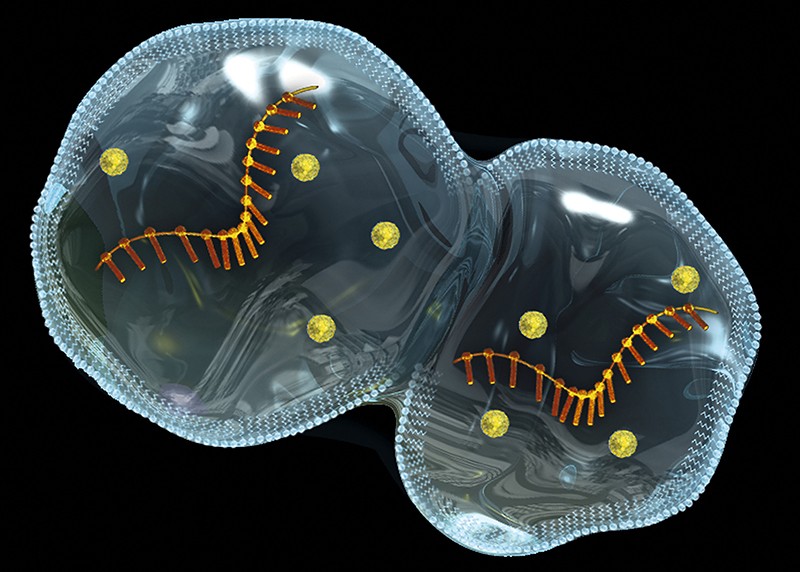A World Beyond Physics: The Emergence and Evolution of Life Stuart A. Kauffman Oxford University Press (2019)

An artist’s impression of early ‘protocells’ proliferating.Credit: Henning Dalhoff/Science Photo Library
Among the great scientific puzzles of our time is how life emerged from inorganic matter. Scientists have probed it since the 1920s, when biochemists Alexsandr Oparin and J. B. S. Haldane (separately) investigated the properties of droplets rich in organic molecules that existed in a ‘prebiotic soup’ on the primitive Earth (see T. Hyman and C. Brangwynne Nature 491, 524–525; 2012). Each hypothesized that organic compounds underwent reactions leading to more complex molecules, and eventually to the first life forms.
What was missing then, as now, is a concrete theory for the physics of what life is, testable against experiment — which is likely to be more universal than the chemistry of life on Earth. Decades after Oparin and Haldane, Erwin Schrödinger’s 1944 book What Is Life? (see P. Ball Nature 560, 548–550; 2018) attempted to lay conceptual foundations for such a theory. Yet, more than 70 years and two generations of physicists later, researchers still ponder whether the answers lie in unknown physics. No one has led the charge on these questions quite like Stuart Kauffman.
In the 1980s and 1990s, Kauffman — a complex-systems researcher — developed a highly influential theory for life’s origins, based on molecules that reproduce only collectively, called autocatalytic sets. He posited that if a chemical soup of polymers was sufficiently diverse, these sets would emerge spontaneously as a phase transition — that is, a significant change in state or function, akin to the shift from solid to liquid. The sets function holistically, mutually catalysing the formation of all their molecular members. (His inspiration was advances in the mathematics of networks by Paul Erdős and Alfréd Rényi, who had demonstrated how phase transitions occur in random networks as connectivity is increased.) Now, in A World Beyond Physics, Kauffman elaborates.
His key insight is motivated by what he calls “the nonergodic world” — that of objects more complex than atoms. Most atoms are simple, so all their possible states can exist over a reasonable period of time. Once they start interacting to form molecules, the number of possible states becomes mind-bogglingly massive. Only a tiny number of proteins that are modestly complex — say, 200 amino acids long — have emerged over the entire history of the Universe. Generating all 20020 of the possibilities would take aeons. Given such limitations, how does what does exist ever come into being?
This is where Kauffman expands on his autocatalytic-sets theory, introducing concepts such as closure, in which processes are linked so that each drives the next in a closed cycle. He posits that autocatalysing sets (of RNA, peptides or both) encapsulated in a sphere of lipid molecules could form self-reproducing protocells. And he speculates that these protocells could evolve. Thus, each new biological innovation begets a new functional niche fostering yet more innovation. You cannot predict what will exist, he argues, because the function of everything biology generates will depend on what came before, and what other things exist now, with an ever-expanding set of what is possible next.
Because of this, Kauffman provocatively concludes, there is no mathematical law that could describe the evolving diversity and abundance of life in the biosphere. He writes: “we do not know the relevant variables prior to their emergence in evolution.” At best, he argues, any ‘laws of life’ that do exist will describe statistical distributions of aspects of that evolution. For instance, they might predict the distribution of extinctions. Life’s emergence might rest on the foundations of physics, “but it is not derivable from them”, Kauffman argues.
...
FREE PDF GRATIS: Nature


